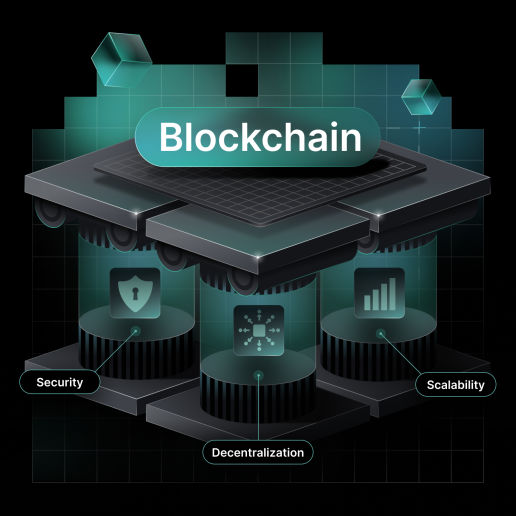Bitcoin began the blockchain revolution in January, 2009. Today, it is still the most popular blockchain, the largest by market cap (approximately $520 billion at time of writing), and indeed the longest-operating.
But Bitcoin isn’t a perfect piece of technology. By design, the Bitcoin network is highly secure and intensely decentralized blockchain with individual users operating nodes around the globe. As crypto security is paramount to the functionality of any blockchain network, this decentralization is a feather in Bitcoin’s cap. But beyond security and decentralization, a blockchain also needs to be highly scalable. This is where Bitcoin has struggled in the past.
The above is a description of the blockchain trilemma: security, decentralization, and scalability. Bitcoin was more or less built to solve two of these pillars (the main blockchain is, as we mentioned, highly decentralized and secure), but scalability has always been an issue as a result. Recent developments in the Bitcoin space (like the Ordinals protocol and the BRC-20 token standard) have also led many users to reiterate the difficulties they face when it comes to transaction speed, transaction times and throughput on Bitcoin.
Barriers to Bitcoin's scalability are what ultimately led to perceptions that it serves mainly as a store of value and a cryptocurrency fit for peer-to-peer transactions, but little else. That narrative has, over time, also driven developers and users to newer blockchains like Ethereum, and much of the dialogue around the Bitcoin protocol has focused on how its lack of scalability impacts its ability to support dApps (decentralized applications) on the existing blockchain.
Fortunately, there are solutions for solving the trilemma on Bitcoin. But first, we'll need to dive into what the Blockchain Trilemma is, and how it impacts blockchain protocols.
Defining the Blockchain Trilemma: Scalability, Decentralization and Blockchain Security

Source: Trust Machines
The "blockchain trilemma," also known as the "scalability trilemma" or the "decentralization trilemma," refers to a concept that highlights the challenges blockchain systems face in balancing between three fundamental properties: scalability, security, and decentralization. It was actually coined by Vitalik Buterin, the co-founder of Ethereum, as a term to describe the set of three main issues that must be solved in blockchain tech.
Decentralization
Decentralization refers to the distribution of power and control among multiple nodes or participants in a blockchain network. It is a core principle of blockchain platforms that is aimed at avoiding single points of failure and to prevent undue influence from one central entity. Decentralization ensures that no single entity can control or manipulate the system.
Security
Security is also a vital aspect of any blockchain system. It ensures that the transactions recorded across the decentralized ecosystem on the blockchain are tamper-proof and cannot be altered by malicious actors. Security is typically achieved through cryptographic algorithms and consensus mechanisms, which require computational resources and time. The higher the security level, the more difficult it becomes for attackers to compromise the system, which is why maintaining blockchain security is so important for the performance of the blockchain.
Scalability
Finally, scalability refers to the ability of a blockchain network to handle a large number of transactions efficiently. It involves the speed and capacity of the network to process and confirm transactions. Higher scalability allows for more transactions to be processed per second, which is crucial for blockchain applications with mass adoption potential.
Achieving scalability is, for many blockchain developers, an essential goal for the adoption of blockchain protocols and the future of blockchain industry. After all, scalability ultimately leads to additional blockchain uses that offer potential solutions for many age-old institutional issues.
No Perfect Blockchain
The blockchain trilemma suggests that it is difficult to achieve optimal levels of scalability, security, and decentralization simultaneously. Improving one aspect often comes at the expense of the others. For example, increasing security and scalability may require sacrificing some decentralization by introducing more efficient consensus mechanisms or reducing the number of validating nodes. Similarly, enhancing decentralization and security may reduce scalability due to the increased computational requirements for cryptographic operations.
Looking at Bitcoin more closely, the Bitcoin blockchain can only support about seven transactions per second. At this moment, that is nowhere near enough for mass adoption, especially compared to a traditional payments network like Visa, which can support about 24,000 transactions per second.
So how can we fix that? For Bitcoin, the answer is layer 2 protocols and other scalability solutions. Layer 2 builds have brought use cases like NFTs, DeFi functionality, and smart contracts to Bitcoin already.
But before we lay out L2s on Bitcoin, we have to understand the structure and function of Bitcoin's layer 1 itself.
Bitcoin's L1: The Original Blockchain Technology
Bitcoin’s layer 1 network is where the blockchain's protocol rules and governance are established. It is the layer that defines how transactions are processed, verified, and recorded on the blockchain. In a public blockchain network, the L1 is where nodes and miners participate in the network to validate transactions and add new blocks to the blockchain. On Bitcoin, this is done through a unique consensus mechanism called Proof of Work (PoW) whereas Ethereum operates on Proof of Stake (PoS).
One of the key features of Layer 1 blockchains is their ability to provide a decentralized, trustless system for peer-to-peer transactions. By utilizing a distributed network of nodes and miners, the blockchain can achieve a high level of security and transparency. The consensus mechanism used in Layer 1 determines how transactions are validated and how new blocks are added to the blockchain.
Solving the Blockchain Trilemma for Bitcoin: Layer 2 Solutions and Use Cases
As we discussed above, it is simply impossible to rely on the base layer for everything. In order to get the most out of Bitcoin and make it a viable solution for billions of people across the globe, both layer-1 and layer-2 solutions are required to successfully solve the trilemma as it applies to Bitcoin.
That's where Bitcoin layers come in.
Bitcoin L2 refers to the additional protocols and technologies on top of the base layer of the Bitcoin blockchain. These additional layers are designed to enhance and expand the functionality of Bitcoin, addressing limitations such as scalability, privacy, and programmability.
The most popular Layer 2 protocol built on Bitcoin is the Lightning Network. Lightning has existed since 2015, and it aims to help Bitcoin solve its scalability problem by allowing users to complete transactions away from Bitcoin’s base layer. Lightning transactions exist in user-generated peer-to-peer channels that allow for near-instantaneous exchange. This solves two problems for Bitcoin: First, it is a massive upgrade on the speed of transactions that occur on the Bitcoin base layer. Second, it allows users to circumvent the difficulty of moving bitcoin in and out of the main chain. Once a Lightning payment channel is created, it can handle unlimited transactions between two parties via smart contracts.
The bottom line is that the Lightning Network is capable of performing a huge amount of the work that it would be slow, cumbersome, and inefficient to leave to Layer 1. Instead of transactions moving back and forth between two parties at a snail’s pace, they can occur in near real-time off-chain, and be packaged for transport back onto the base layer in the form of updated balance sheets for both transacting parties.
Additionally, layers like Stacks and Rootstock (RSK) have introduced additional features, like smart contract functionality, to Bitcoin, as well as other distinct consensus mechanisms for the Bitcoin ecosystem (Liquid). Each layer features its own solutions to the problems found on Bitcoin's L1, and hold the key to addressing the blockchain's scalability issues. Namely, they hold the key to increasing the scope of what is possible on Bitcoin, including expanding on use cases for Bitcoin like NFTs, DeFi, and integration into traditional, centralized platforms.
Building a Scalable Bitcoin Blockchain
Bitcoin is not only the original decentralized network, but recent developments in the ecosystem have also highlighted the issues builders face every day, no matter the blockchain platform.
Because ultimately, the blockchain trilemma is a concern for any blockchain ecosystem as developers seek to address scalability, decentralization or security issues at any given time. Developers who believe that blockchain networks can address many longstanding economic, financial and social concerns will need to address the trilemma as they seek any sort of mass adoption.
In Bitcoin's case, if scalability is the lock separating Bitcoin from mass adoption, layer 2 protocols are the key that can open the door.

